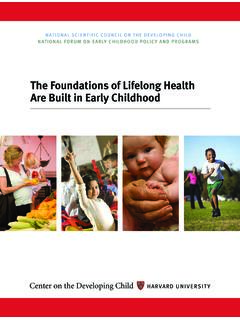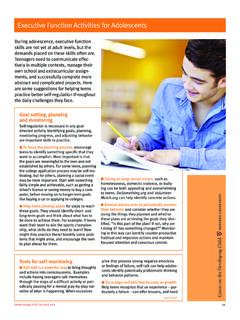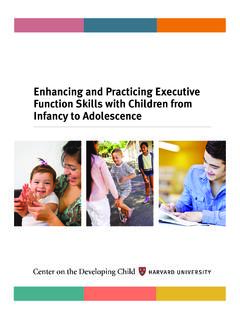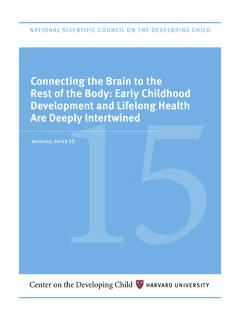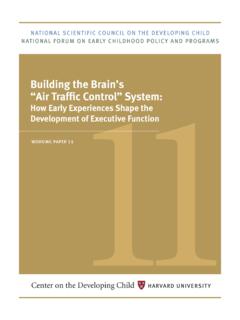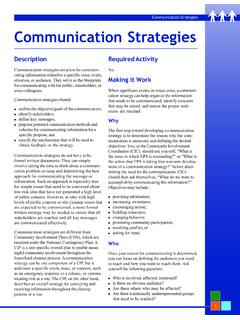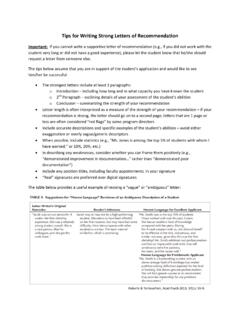Transcription of Brains are built over time, from the bottom up
1 1 Brains are built over time, from the bottom up. The basic architecture of the brain is con-structed through an ongoing process that begins before birth and continues into adulthood. Early experiences affect the quality of that architecture by establishing either a sturdy or a fragile foundation for all of the learning, health and behavior that fol-low. In the first few years of life, more than 1 million new neural connections are formed every second. After this period of rapid proliferation, connections are reduced through a pro-cess called pruning, so that brain circuits become more efficient. Sensory pathways like those for basic vision and hearing are the first to develop, followed by early language skills and higher cognitive functions.
2 Connec-tions proliferate and prune in a prescribed order, with later, more complex brain circuits built upon earlier, simpler circuits. 2 The interactive influ-ences of genes and experience shape the developing brain. Scientists now know a major ingredi-ent in this developmental process is the serve and return relationship between children and their parents INBRIEF | THE SCIENCE OF EARLY CHILDHOOD DEVELOPMENTA series of brief summaries of the scientific presentations at the NationalSymposium on Early Childhood Science and science of early brain development can inform investments in early childhood. These basic concepts, established over decades of neuroscience and behavioral research, help illustrate why child development particularly from birth to five years is a foundation for a prosperous and sustainable society.
3 POLICY IMPLICATIONSl The basic principles of neuroscience indicate that early preventive intervention will be more ef-ficient and produce more favorable outcomes than remediation later in life. l A balanced approach to emotional, social, cognitive, and language development will best pre-pare all children for success in school and later in the workplace and Supportive relationships and positive learning experiences begin at home but can also be pro-vided through a range of services with proven effectiveness factors. Babies Brains require stable, caring, interactive relationships with adults any way or any place they can be provided will benefit healthy brain Science clearly demonstrates that, in situations where toxic stress is likely, intervening as early as possible is critical to achieving the best outcomes.
4 For children experiencing toxic stress, special-ized early interventions are needed to target the cause of the stress and protect the child from its the proliferation and pruning process, simpler neural connections form first, followed by more complex circuits. The timing is genetic, but early experiences determine whether the circuits are strong or weak. and other caregivers in the family or community. Young children naturally reach out for interaction through babbling, facial expressions, and gestures, and adults respond with the same kind of vocalizing and gesturing back at them. In the absence of such responses or if the responses are unreliable or inappropriate the brain s architecture does not form as expected, which can lead to disparities in learning and behavior.
5 3 The brain s capacity for change decreases with age. The brain is most flexible, or plastic, early in life to accom-modate a wide range of environ-ments and interactions, but as the maturing brain becomes more specialized to assume more complex functions, it is less capable of reorganizing and adapting to new or unexpected challenges. For example, by the first year, the parts of the brain that differentiate sound are becoming specialized to the language the baby has been ex-posed to; at the same time, the brain is already start-ing to lose the ability to recognize different sounds found in other languages. Although the windows for language learning and other skills remain open, these brain circuits become increasingly difficult to alter over time.
6 Early plasticity means it s easier and more effective to influence a baby s developing brain architecture than to rewire parts of its circuitry in the adult years. 4 Cognitive, emotional, and social capacities are inextricably intertwined throughout the life course. The brain is a highly interrelated organ, and its multiple functions operate in a richly coordinated fashion. Emotional well-being and social competence provide a strong foundation for emerging cognitive abilities, and together they are the bricks and mortar that comprise the foundation of human develop-ment. The emotional and physical health, social skills, and cognitive-linguistic capacities that emerge in the early years are all important prerequisites for success in school and later in the workplace and com-munity.
7 5 Toxic stress damages developing brain archi-tecture, which can lead to life-long problems in learning, behavior, and physical and mental health. Scientists now know that chronic, unrelenting stress in early childhood, caused by extreme poverty, repeated abuse, or severe maternal depression, for example, can be toxic to the developing brain. While positive stress (moderate, short-lived physi-ological responses to uncomfortable experiences) is an important and necessary aspect of healthy development, toxic stress is the strong, unrelieved activation of the body s stress management system. In the absence of the buffering protection of adult support, toxic stress becomes built into the body by processes that shape the architecture of the devel-oping brain.
8 _____For more information, see The Science of Early Childhood Development and the Working Paper series from the National Scientific Council on the Developing NGA Center for BEST PRACTICESNATIONAL CONFERENCEof STATE LEGISLATURESTHE INBRIEF SERIES:INBRIEF: The Science of Early Childhood DevelopmentINBRIEF: The Impact of Early Adversity on Children s DevelopmentINBRIEF: Early Childhood Program EffectivenessINBRIEF: The Foundations of Lifelong subjected to toxic stress have underdeveloped neural connections in areas of the brain most important for successful learning and behavior in school and the workplace.
